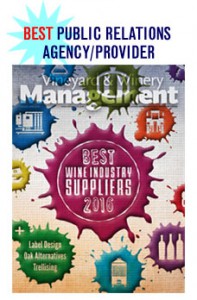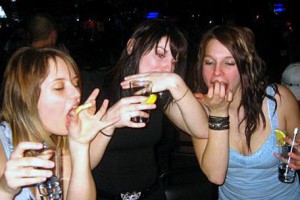It’s traditional to look back at the end of the year and assess what’s been. However, it’s much more fun, and profitable, to take what you’ve seen and look forward with an attempt to anticipate what’s to come and what trends will emerge. Since we are all about fun and profit, we choose the latter.
Below is a list of the trends we believe deserve watching. Some listed below we see as being solidified in the coming year. Others we think might emerge as important trends that wine marketers and publicists will benefit from keeping a very close eye on. They are listed in no particular order
1. “Natural Wine” Is Solidified As A Bonafide “Category” in the Wine World
Despite our skepticism that “natural wine” has any meaning whatsoever, we have seen this moniker applied to wines by very reputable publications and many wine professionals. It has been embraced enough that it will be solidified as a category to be watched. However, that also means that the term “natural wine” will be used by marketers who will take advantage of the fact that the term means nothing. Think “Reserve.”
2. Continuing Backlash Against the Wine Industry in Well Developed Wine Regions
Napa and Sonoma in particular will continue to see very vocal minorities demanding that the wine industry be penalized or burdened with new regulations in order to address problems this minority believes is caused by the wine industry. Traffic problems, new wine developments where vineyards have previously not been tended and winery-based marketing events will all continue to be assailed by the vocal minority. That said, there is every reason to believe the industry and the majority in these regions who support it will push back against calls to punish and curtail wine production and marketing.
3. Distributor Consolidation
Consolidation almost always breeds additional consolidation as those not involved in the consolidation seek to keep pace. In 2014 we saw huge, multi-state distributors become even bigger via consolidation. There remain a few large distributors that are ripe for the picking and in need of merging to keep up with the behemoths. We expect more consolidation in the wholesale tier in the coming year.
4. The Emergence of Younger Wine Writers
We believe 2016 will be an important year in the emergence of a new, younger crop of wine writers. As the older, experienced crew begins to think about retirement, the new crew will be selected from successful bloggers and young writers who have been toiling at second tier wine publications and websites. In other words, we expect to see promotions to the big leagues of younger wine writers.
5. Increase in Use of Media (not Social) Relations in the Wine Industry
We have seen a distinct increase in wineries and wine companies inquiring about help reaching the media with their brand message. This increase in interest in traditional media relations might be due to numerous developments. We see it as a response to the continued increase in brand choices and a need to sing louder and more clearly among a growing chorus of voices seeking an audience.
6. Opportunity in Diversity
Americans are more promiscuous in their drinking, whether migrating to different types of wines from the traditional varietals or migrating across categories to try new beers, ciders and spirits instead of sticking with their tried and true wines. Expect to see more wineries experimenting in different categories whether it’s distilling or cider-making or more.
7. More Groups and More Categories To Choose From
You’ve got varietal groups (ZAP), style groups (IPOB), regional groupings from new AVAs to their promoters. Expect even more groups to emerge in all these categories primarily as means for collective marketing efforts. It’s getting tougher and tougher out there to get share of mind and group marketing is an effective and affordable way to spread the word.
8. More Virtual Wineries as Cost of Entry Continues to Increase
You can expect to see more “virtual wineries” (no winery, no vineyards, no ‘bricks and mortar’ tasting rooms) emerge as the cost of entry into the California and Oregon and Washington wine industries continue to increase in cost and regulatory hurdles. Born only as brands, these “virtual wineries” will be run by (or should be run) by good marketers since, well, that’s primarily what their business is all about. Additionally, such brands can be created to appeal directly to specific groups, demographics and cohorts since there is no obligation to spend much of any time speaking about place and heritage.
9. The Call For Expertise
The bubble in which wine consumers, trade, and media shout their thoughts is getting more crowded and louder and that cacophonous buzz is becoming deafening. We expect many consumers to more actively seek out vetted expertise in their pursuit of wine advice, recommendations and education. This is in contrast to the rise of the Everyman Wine Critic and the Crowd as the source of knowledge in our digital world. And CellarTracker and Delectable aren’t going anywhere. We realize this. But we see something else also. The continued success of Wine Spectator, Wine Enthusiast, Wine Advocate, World of Fine Wine and other sources of vetted wine information along with the rise of the Somm and repeated calls to “find a local wine shop” is evidence that consumers are looking for real expertise to help guide them.
10. Purposeful Authenticity Will Be More Important Than Ever
Next year is a presidential election year and this means that despair and cynicism will reach its four-year high. The constant barrage of “talking points,” scandals, meanness and more will have people looking for content with real purpose and true authenticity as those they are willing to give time to. Those wine companies that can provide their community or constituents with real, heart to heart, meaningful, authentic content will capture hearts, minds and possibly wallets.
Have you spotted any trends the wine industry needs to be aware of going into 2016? Please leave them in the comments section of this post below. We want to hear what you see.
 For those of you who know my partner in SWIG, Julie Ann Kodmur, you know she’s overly modest. I know, unusual for a PR type. Still, she is a modest one. So modest is she that she was going leave unsaid on this blog that she was JUST AWARDED BEST PUBLIC RELATIONS AGENCY/PROVIDER by Vineyard and Winery Management Magazine.
For those of you who know my partner in SWIG, Julie Ann Kodmur, you know she’s overly modest. I know, unusual for a PR type. Still, she is a modest one. So modest is she that she was going leave unsaid on this blog that she was JUST AWARDED BEST PUBLIC RELATIONS AGENCY/PROVIDER by Vineyard and Winery Management Magazine.


